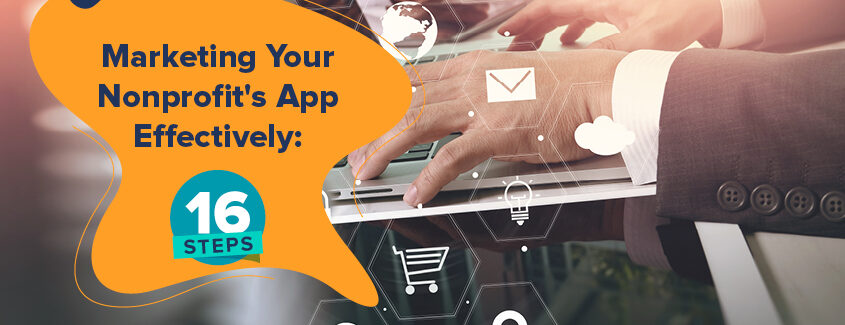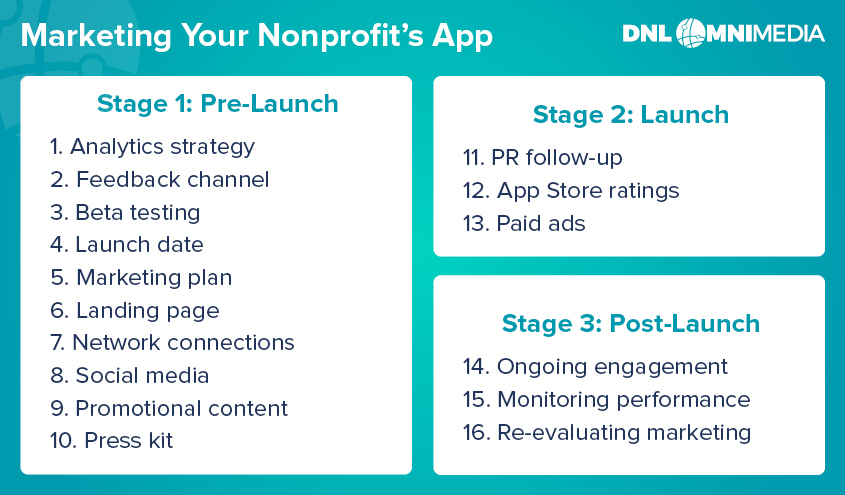
Custom mobile apps are a powerful way to engage your supporters, especially today, as virtual engagement increasingly becomes the norm for missions of all sizes. Consider these statistics:
1 in 5 Americans access the Internet primarily through a smartphone.
1 in 4 donors use mobile devices to discover and learn about new nonprofits.
25% of donors complete their donations using mobile devices.
As virtual fundraising and the broader shift towards digital strategies intensify across the sector, these numbers will continue to increase. This is why mobile fundraising and advocacy apps are such effective tools for nonprofits looking to directly engage supporters and expand their reach online.
If you’ve already invested in a custom nonprofit mobile app, you already know many of the benefits of these powerful tools. However, you might have a few questions about the best ways to put your new app to work.
We’ve got you covered. Here’s how we recommend marketing your nonprofit’s app effectively:

Let’s walk through the pre-launch, launch, and post-launch stages, covering the essentials of each step along the way. If you have any questions as you begin developing a marketing and launch strategy for your app, don’t hesitate to contact us for support. Let’s dive in.

Stage 1: Pre-Launch
1. Develop an analytics strategy.
Measuring and monitoring app engagement and user behavior can provide invaluable insights into how to strengthen your strategies over time. Your mobile app will allow you to collect and track these data points.
However, without a concrete idea of what you’re looking for, all of that engagement data can quickly become overwhelming. Develop an analytics strategy early in the process of bringing your app online.
Specifically, define the metrics that are most interesting and useful for your organization. What do you want to learn about your app’s performance and user experience? What insights will be the most valuable for refining your mobile fundraising and marketing strategies?
Select the KPIs that are most relevant for your goals and your app’s target audience. Then, doublecheck that you’ve got a solid infrastructure in place to collect that data and report it to your CRM for further analysis.
2. Provide an in-app feedback channel.
Before finalizing any new strategies and plans for your app, make sure you have an in-app feedback channel for users to report issues.
Provide users with an intuitive, built-in way to complete these tasks:
- Report technical issues
- Communicate with your nonprofit’s team
- Submit suggestions or requests
- Ask for help
An in-app feedback channel will help prevent negative user reviews because it gives users an easy alternative to leaving low star ratings out of frustration. When you’re able to quickly address any issues that arise from your supporters, you can significantly decrease the chances of a negative user experience and thus boost user retention.
3. Conduct beta testing.
The main goal of beta testing is to get real-world experience and insights into how well your app will perform with actual users after it’s launched. Beta testing is extremely important, so don’t neglect this crucial step.
Set up a beta release to find bugs, test all potential user interactions, and study other implementation-based elements like loading times.
Collecting and analyzing these insights will help you catch any major issues that need work before continuing with your app’s launch. Additionally, it can help you make smaller, iterative changes to your app’s user interface to ensure you’re offering the best possible user experience.
4. Set a launch date.
It’s important to pick a comfortable launch date for your app early in the process. This will allow you to plan development updates and marketing activities around the release schedule without rushing your team and risking major issues.
Once you set a launch date, develop a launch checklist for internal use. There will be multiple elements and tasks that need to be coordinated, so it helps to be as organized as possible.
Additionally, keep track of any major announcements from nonprofit stakeholders in the tech world. This can ensure your app’s release date doesn’t coincide with other tech events. You definitely don’t want your app launch to be overshadowed after all the hard work you’ve invested in it.
5. Develop a marketing plan.
You’ll need to actively promote your app prior to it hitting the app store. Once you’ve finalized all of your app’s core features and functions, it’s time to involve your marketing team.
Brainstorm ways to spread awareness of your app that could bump you to the top of the store on launch day. Marketing an app requires planning and a range of digital marketing techniques and outlets.
Just as the entire process for launching your app is divided into three stages, we recommend taking a similar marketing approach. Subdivide your app marketing strategy into pre-launch, launch, and post-launch phases, and clearly outline any specific elements and goals at each step.
6. Create a landing page.
It’s never too early to start generating excitement and creating a fanbase for your new app! A well-designed landing page that promotes your app, its features, and launch date with exciting text and screenshots can be highly effective for creating a buzz.
The core goal is to create an engaging landing page with calls-to-action and a contact form to collect potential users’ email addresses. Plus, having a dedicated landing page in place early on gives you a central location to point readers towards in your marketing campaign.
Invite users to sign up for launch notifications and offer social media sharing tools for fans to start recommending your app to others.
7. Extend your network.
During app development, it’s important to focus some attention on extending your network of partners. Consider these tactics:
- Identify nonprofit influencers who may be interested in your app.
- Research the publications that cover and review nonprofit apps that fall in the same category as yours. Identify who at each publication would be most excited about your new offering.
- Participate in communities popular with your target audience. Visit any forums that might be relevant to your target users and start engaging in that space.
As launch day approaches, reach out to your full list of media contacts. Choose a handful of reporters, publications, and news outlets that you have relationships with to let them know your specific release date and time.
8. Leverage social media.
Social media should be a central part of your promotional strategy. Establish a social presence on platforms like Facebook, Twitter, and LinkedIn early on in the development process.
Drive interest, excitement, and engagement for your new app with announcements, screenshots, previews, and more. Drive traffic to your landing page and app store listings whenever possible so that readers can join a waiting list or a group to receive immediate announcements on launch day.
By leveraging social media at all three stages of the app launch process, you can attract your target audience, generate downloads, and build engagement and awareness with potential users.
9. Create promotional content.
We recommend employing video formats for your promotional content because it tends to generate higher engagement online. Plus, video is one of the most expressive ways to show off your app in action.
Strong multimedia content can supercharge your marketing efforts, especially on social media. Its ability to convince viewers to download and try out your app makes the production process a worthwhile investment. Plus, creating video content provides you with the opportunity to establish a voice and set the value proposition of your app.
Create different pieces of promotional content for different purposes in your broader marketing strategy. An initial announcement video, a “sneak peek” video, and a comprehensive video tour are all great examples that can help drive organic downloads.
10. Create a press kit.
If a journalist or blogger can’t find information about your app, they’ll be unlikely to write about it. Avoid this problem by proactively creating a press kit to provide interested members of the media.
Create a single file where outside parties can access everything they’ll need to write about your app, including:
- A press release
- Store icon and screenshots
- A video demo
- An app description
- Previous reviews
- Information about your organization
Reporters and bloggers should be able to publish content about your app right when it launches, so send them your press kit in advance. Having your press kit ready to go lets you hit the ground running on launch day and start generating downloads.

Stage 2: Launch
11. Follow up with PR.
Press is the best way to kickstart your app, and the most effective way to get press is to manually reach out to journalists. At this stage, it’s time to implement the press kit you prepared earlier and contact the list of reporters, bloggers, and influencers that you’ve compiled. Check in with them to remind them when you’re launching your app and when they should announce it.
Remember, an article from a major nonprofit tech blog is a great way to increase traffic and download rates right off the bat. Send information about your app’s launch to popular app review sites and any other publications that you think are relevant.
12. Generate ratings on app stores ASAP.
Obtaining as many positive reviews as possible on your app’s release day will be key for sustained success. A strong average rating will help attract new downloads from users browsing the stores. This is the best way to make your app stand out on the store’s homepage, gain visibility, and achieve organic downloads.
Immediately begin asking users to submit reviews. Start with your community, friends, and family (and most importantly, your test users). Make sure to also alert your email list generated from your landing page about your app’s availability and ask them to leave a review.
13. Use paid ads.
Paid acquisition can be expensive for ongoing growth, but it’s a solid strategy for a limited app launch campaign to build initial awareness and downloads.
Paid ads can give your app the boost it needs to gain visibility during its first few days and kickstart organic growth. This snowball effect from wide initial awareness and positive reviews can majorly benefit the app over time.

Stage 3: Post-Launch
14. Plan an ongoing engagement strategy.
Develop a strategy specifically to maintain engagement with your app users over the long run. Engaged users are more likely to take action on advocacy alerts, start or join events, actively manage their giving, and give your positive reviews. They’re definitely the most valuable users to have on your side, so re-engaging them is a must-do.
Consider how you’ll build user engagement over time with features like push notifications and in-app messaging, and have a plan to regularly check on your engagement metrics.
15. Monitor your app’s performance.
Measuring and monitoring key metrics allows you to understand your users and their usage patterns. This information can then help you identify where and how your app can be improved.
For example, in-app analytics can provide insights into the popular “flow” of your app, or how users progress through different locations and features. Continually monitoring performance also helps to flag any issues that may be causing app dropouts or abandonment.
Keep in mind, app analytics are not a siloed resource. Rather, analytics should be integrated with all the other channels where your brand collects engagement data.
Monitor your app store rankings, trends in download growth, feedback streams, reviews, and social signals to assess your performance and user satisfaction over time. A combination of in-app metrics and external mentions on social media or Google Alerts will help you gain a comprehensive understanding of your app’s position in the marketplace.
Social media is particularly useful for gauging user sentiment and perceptions of your app. These channels are often the first place users go to complain when something isn’t working. Tracking social media engagement is also valuable for finding out which channels are most effective for promotion, which can then help you better target your paid advertising strategy.
16. Re-evaluate your marketing strategy.
After launching your app, continue leveraging the analytics discussed above to better understand where to focus your marketing efforts and engage users. A solid marketing plan will help drive new app installs and re-engage target users, boosting your app loyalty and retention.
Your marketing strategy will need to evolve as your app user evolves. Think critically and creatively to come up with concrete ideas and plans to continuously enhance the promotion of your app.
This might mean expanding into other value paths, targeting new audience segments, and even redefining the direction of your app’s roadmap. Periodic paid promotion campaigns can also help keep your app visible in the market and extend the momentum generated by your initial launch.
Launching an app successfully requires more than just technical elements. Effective marketing and promotion are essential for generating interest and keeping users engaged over the long run. These core steps can help you build a strategy that sets your new app up for success.
If you have any questions or want to discuss other best practices for promoting your app, please get in touch. We’ll be happy to help!
